Bikaner
 Bikaner is a beautiful city located on the edge of Thar desert, in the Northern Rajasthan. It is famous for the old Havelies and world’s largest Camel Research Farm. The city was founded by Bika in 1486 AD, he was the son of Rao Jodha. It is also know as camel country and famous for the best riding camels in the world. The exotic camel safaris, its gorgeous forts and the worship of thousands of holy rats at Karni Mata temple are some of the most interesting aspects of Bikaner. The camel festival at Bikaner held in the month of January is also an event worth witnessing if one wants to get the actual color of the place. You can witness here a rare Hindu and Mughal art is safely preserved. The old city is walled and consists of many intricately carved palaces and temples. The fort is remarkably well preserved. It was attacked many times but never conquered. Bikaner is popularly known as the Camel Country and famous for the camel races that are held here. The Camel Research Farm is just 8 Kms from the city and is a place to visit and a good place to go to if you still have a few hours to kill. The city covers only an area of just 38.10 Sq. Kms and has more interesting sights to offer, for example, the Har Mandir, Lalgarh Palace and the nearby Gajner Wild Life Sanctuary.
Bikaner is a beautiful city located on the edge of Thar desert, in the Northern Rajasthan. It is famous for the old Havelies and world’s largest Camel Research Farm. The city was founded by Bika in 1486 AD, he was the son of Rao Jodha. It is also know as camel country and famous for the best riding camels in the world. The exotic camel safaris, its gorgeous forts and the worship of thousands of holy rats at Karni Mata temple are some of the most interesting aspects of Bikaner. The camel festival at Bikaner held in the month of January is also an event worth witnessing if one wants to get the actual color of the place. You can witness here a rare Hindu and Mughal art is safely preserved. The old city is walled and consists of many intricately carved palaces and temples. The fort is remarkably well preserved. It was attacked many times but never conquered. Bikaner is popularly known as the Camel Country and famous for the camel races that are held here. The Camel Research Farm is just 8 Kms from the city and is a place to visit and a good place to go to if you still have a few hours to kill. The city covers only an area of just 38.10 Sq. Kms and has more interesting sights to offer, for example, the Har Mandir, Lalgarh Palace and the nearby Gajner Wild Life Sanctuary.
HOW TO REACH
By Air - Jodhpur is the nearest airport i.e. 256 Kms. There are daily fights to Jaipur, Delhi & Mumbai from Jodhpur.
By Rail - Bikaner Railway Station is well connected to the other major cities with regular & express trains like Jaipur-Bikaner Express, Intercity Express, Ranakpur Express and Sarai Rohilla Express.
By Road - Bikaner is well connected to the major cities of Rajasthan by roads. You can try the Rajasthan State Transport buses or private luxury coaches.
WHEN TO GO Best time to travel Bikaner is between October to March.
WHAT TO SEE
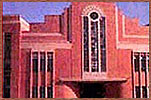 Ganga Golden Jubilee Museum - It was established in 1937 on the eve of the Golden jubilee celebrations of Maharaja Ganga Singh, this Museum now run by the Government of Rajasthan. It was located near the Lalgarh Palace in Bikaner & was shifted to a new building in the Civil lines in 1954. This museum is displays an excellent collection of Terracotta ware, weapons, maniature paintings of Bikaner school and coins. The exhibits are splendid master pieces of Harappan civilisation, Gupta and Kushan era and sculptures of the late classical time.
Ganga Golden Jubilee Museum - It was established in 1937 on the eve of the Golden jubilee celebrations of Maharaja Ganga Singh, this Museum now run by the Government of Rajasthan. It was located near the Lalgarh Palace in Bikaner & was shifted to a new building in the Civil lines in 1954. This museum is displays an excellent collection of Terracotta ware, weapons, maniature paintings of Bikaner school and coins. The exhibits are splendid master pieces of Harappan civilisation, Gupta and Kushan era and sculptures of the late classical time.
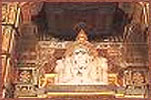 Bhandasar Jain Temple - The 15 century Temple,is the oldest and distinct monument of bikaner dedicated to Sumati Nath Ji,the 5th Tirthankar of the Jain Religion.The temple is decorated with rich mirror work, frescoes and gold leaf paintings..The beautiful temple was erected near Laxminath temple in 1540A.D.Pure ghee (butter oil) and coconuts were reported to have been used in laying the foundation. Carved in red sand stone and white marble – its famous for carvings ,wall paintings , structural beauty and artistically designed statues. Distance :5 km.
Bhandasar Jain Temple - The 15 century Temple,is the oldest and distinct monument of bikaner dedicated to Sumati Nath Ji,the 5th Tirthankar of the Jain Religion.The temple is decorated with rich mirror work, frescoes and gold leaf paintings..The beautiful temple was erected near Laxminath temple in 1540A.D.Pure ghee (butter oil) and coconuts were reported to have been used in laying the foundation. Carved in red sand stone and white marble – its famous for carvings ,wall paintings , structural beauty and artistically designed statues. Distance :5 km.
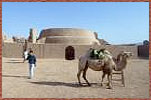 Camel Research Centre - The National Research Centre on Camel, Bikaner is located in the Jorbeer area at a distance of about 10 km from Bikaner city. It was established on 5th July 1984. Prior to that the Centre was known as camel breeding farm under the aegis of college of Veterinary and Animal Science, Rajasthan Agricultural University, Bikaner. The Centre has the responsibility to conduct basic and applied research for the improvement of camel. The Centre has been identified as one of the important tourist place of Bikaner and is included in the tourist map of Rajasthan. The Centre has developed a camel museum which attracts the attention of researchers and tourist. Every year thousands of Foreign and Indian tourists visit the Centre.
Camel Research Centre - The National Research Centre on Camel, Bikaner is located in the Jorbeer area at a distance of about 10 km from Bikaner city. It was established on 5th July 1984. Prior to that the Centre was known as camel breeding farm under the aegis of college of Veterinary and Animal Science, Rajasthan Agricultural University, Bikaner. The Centre has the responsibility to conduct basic and applied research for the improvement of camel. The Centre has been identified as one of the important tourist place of Bikaner and is included in the tourist map of Rajasthan. The Centre has developed a camel museum which attracts the attention of researchers and tourist. Every year thousands of Foreign and Indian tourists visit the Centre.
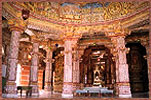 Laxmi Nath Temple - Lakshmi Nath Temple is one of the oldest temples of Bikaner. The foundation of Bikaner was laid here in the year 1488 A.D. by Rao Bikaji. It being a historical monument has special identity. This temple was erected during the reign of Rao Lunkaran and boasts of the superb archeological skills of artists and artisans . It was later develpoed by Maharaja Ganga Singh Ji. Statues of deities- Vishnu and Laxmi – have all along received the unwavering devotion of countless people through the last four and half centuries.
Laxmi Nath Temple - Lakshmi Nath Temple is one of the oldest temples of Bikaner. The foundation of Bikaner was laid here in the year 1488 A.D. by Rao Bikaji. It being a historical monument has special identity. This temple was erected during the reign of Rao Lunkaran and boasts of the superb archeological skills of artists and artisans . It was later develpoed by Maharaja Ganga Singh Ji. Statues of deities- Vishnu and Laxmi – have all along received the unwavering devotion of countless people through the last four and half centuries.
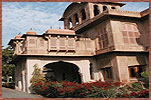 Lallgarh Palace and Sadul Museum - The architectural masterpiece in red sandstone, the palace was built by Maharaja Ganga Singh (1881-1942 A.D.) in the memory of his father Maharaja Lal Singhji in 1902 AD. The palace has beautiful latticework and filigree work. Sprawling lawns with blooming bougainvillea and dancing peacocks make it to be a not -to-be missed visual treat. This oriental fantasy Designed by Col. Sir Swinton Jacob, is entirely a hybrid architecture -a mixture of different elements of Rajput, Muslim and European styles and can be categorized as Indo-Seresanic style. The Rajput exterior of this palace contrasts dramatically with the occidental decor within. The intricately dexterous carving on red sandstone is a hallmark of great craftsmanship. The exotic palace has magnificent pillars, richly carved fire mantles , Italian colonnades and motif of lotus in full bloom , adding to the magic of this jewel of the desert. Walls of palaces are reminiscent of the past vintage etchings, hunting trophies and old portraits. The palace has it’s own museum and library (the fourth largest in the world), clay pigeon trap and skeet shooting traps facilities at adjoining ranges.
Lallgarh Palace and Sadul Museum - The architectural masterpiece in red sandstone, the palace was built by Maharaja Ganga Singh (1881-1942 A.D.) in the memory of his father Maharaja Lal Singhji in 1902 AD. The palace has beautiful latticework and filigree work. Sprawling lawns with blooming bougainvillea and dancing peacocks make it to be a not -to-be missed visual treat. This oriental fantasy Designed by Col. Sir Swinton Jacob, is entirely a hybrid architecture -a mixture of different elements of Rajput, Muslim and European styles and can be categorized as Indo-Seresanic style. The Rajput exterior of this palace contrasts dramatically with the occidental decor within. The intricately dexterous carving on red sandstone is a hallmark of great craftsmanship. The exotic palace has magnificent pillars, richly carved fire mantles , Italian colonnades and motif of lotus in full bloom , adding to the magic of this jewel of the desert. Walls of palaces are reminiscent of the past vintage etchings, hunting trophies and old portraits. The palace has it’s own museum and library (the fourth largest in the world), clay pigeon trap and skeet shooting traps facilities at adjoining ranges.
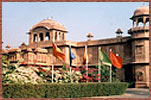 Bikaner royal family still lives in part of the palace. part of the palace has been converted into a luxury hotel and a museum known as Shri Sadul museum which was donated by late his highness maharaja Dr. Karni Singhji of Bikaner to Maharaja Shri Ganga singhji Trust Bikaner in the year 1972 . Princess Rajyashree Kumari of Bikaner, Chairperson of Trust played a very important role in the establishment of this museum.
Bikaner royal family still lives in part of the palace. part of the palace has been converted into a luxury hotel and a museum known as Shri Sadul museum which was donated by late his highness maharaja Dr. Karni Singhji of Bikaner to Maharaja Shri Ganga singhji Trust Bikaner in the year 1972 . Princess Rajyashree Kumari of Bikaner, Chairperson of Trust played a very important role in the establishment of this museum.
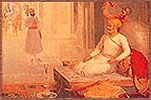 The museum covers the entire first floor of the Lallgarh palace and depicts the lives and times of three successive – Maharaja Ganga Singh, Sadul Singh and Karni Singh through the various artifacts and photographs displayed in 22 rooms.
The museum covers the entire first floor of the Lallgarh palace and depicts the lives and times of three successive – Maharaja Ganga Singh, Sadul Singh and Karni Singh through the various artifacts and photographs displayed in 22 rooms.
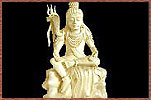 Shiv Bari Temple - Built by Dungar Singhji in the late 19th century. The temple is surrounded by an embattlement wall. It has four-faced black marble Shiva statue and a bronze Nandi facing the Shiva-Lingam. There are two large reservoirs of water known as bawaris. This red sandstone temple attracts thousands of visitors during Shravan (Feb) especially on mondays.
Shiv Bari Temple - Built by Dungar Singhji in the late 19th century. The temple is surrounded by an embattlement wall. It has four-faced black marble Shiva statue and a bronze Nandi facing the Shiva-Lingam. There are two large reservoirs of water known as bawaris. This red sandstone temple attracts thousands of visitors during Shravan (Feb) especially on mondays.
 A splendid temple building made of white marble :- It is a fime example of Indo-Mugal architecture, situated on King Edwats Memotial Road, near Junagarh Fort. The temple was built by the 18th rular of Bikaner state, Lork Ratan Singh, in 1846 A.D., It is dedicated to Lord Krichna. The outer portion of this this temple has an ethereal beauty. The xanctum of the temple is unique where the idol of lord Krishna and his wife and his girl friend are fixed. The temple has very spaciors quadrangle floor made of marble. Arcade design beside the Quadrangle floors mades the sight very magnificent. You are recommended to see the sight of this lovely temple.
A splendid temple building made of white marble :- It is a fime example of Indo-Mugal architecture, situated on King Edwats Memotial Road, near Junagarh Fort. The temple was built by the 18th rular of Bikaner state, Lork Ratan Singh, in 1846 A.D., It is dedicated to Lord Krichna. The outer portion of this this temple has an ethereal beauty. The xanctum of the temple is unique where the idol of lord Krishna and his wife and his girl friend are fixed. The temple has very spaciors quadrangle floor made of marble. Arcade design beside the Quadrangle floors mades the sight very magnificent. You are recommended to see the sight of this lovely temple.
WHERE TO EAT
There few good restaurants which serves Rajasthani, Indian and Continental dishes. You can try the multi cuisine restaurants at the luxury hotels.








